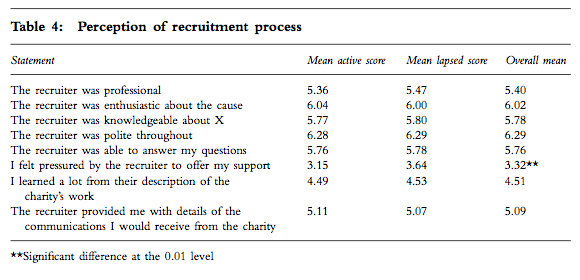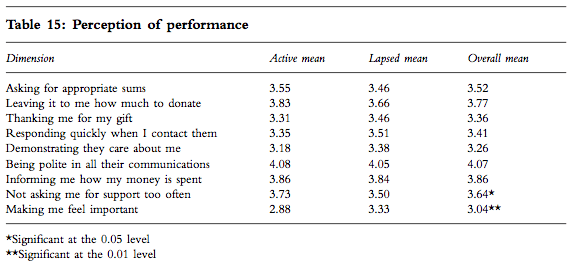The problem of face to face attrition
A few weeks ago I was preparing to give a presentation at the PFRA AGM. With a few days notice, I was told I wouldn't be needed. I'm not actually sure why it was decided I wouldn't be required. I've heard that it was in response to complaints that I would be conducting a pitch rather than giving a considered view on what was right and wrong about face to face recruitment.
The only thing I know for sure is that those people who complained are wrong.
I've always firmly believed that the whole sector is improved if we share our learning. That's one of the reasons why all the Bluefrog research (which has cost many tens of thousands of pounds) is available free of charge either through the main Bluefrog site or here on queerideas.
And though the AGM saw some very positive figures being announced with 680,000 donors recruited in the year ending March 2009 – up 16% on the previous year, there have been more recent press releases that shows the other side of the story – attrition. The projections that we will see first year attrition rates of between 55 and 57% perhaps need double checking.
I've seen the actual data from a large number of campaigns and can say that the actual figures will be at least ten percent higher with real attrition for many organisations now standing between 65 and 70% in year one. And yes, door to door attrition is better – but I haven't seen any results as good as this report would suggest.
The fact is that attrition rates have been continuing to rise year on year – recession or no recession. And though it is likely that the recent economic figures have had an impact, they are not the real problem.
When in doubt about any matter, I normally turn to Adrian Sargeant for an answer and way back in 2003, he pointed us in the right direction.
Working with Elaine Jay, they surveyed 657 active and 431 lapsed face to face recruited donors (from a sample of 4,846) and found that people were relatively happy with the recruitment process. They made the point that it is possible to speculate that…
"…whatever reason individuals might give for lapsing, it has little to do with the perceived quality of the recruitment process".
 In order to cast a little light on what the actual reasons might be, Sargeant and Jay looked at the ongoing donor / charity relationship and asked respondents how they felt their charity performed on a number of areas relating to supporter service.
In order to cast a little light on what the actual reasons might be, Sargeant and Jay looked at the ongoing donor / charity relationship and asked respondents how they felt their charity performed on a number of areas relating to supporter service.
This revealed that charities were scored lowest on two areas that in a commercial setting would be corporate suicide…
- making me feel important
- demonstrating that they care about me
I should point out that their research also indicated that donors said that they didn't rate these components of the relationship as being important. So maybe it is something that we can ignore.
Or maybe not…
The most recent research undertaken by Professor Sargeant shows something very different. By making welcome calls, personalising communications and customising newsletters for face to face recruited donors – in short, using standard fundraising techniques that are proven to increase income and loyalty – their retention can be improved.
In the face of this, I don't understand why so much blame for attrition has been focussed on the recruitment process. On one hand it has benefitted charities, resulting in ever larger replacement guarantees being offered, but the downside has been that the motivation for charities to develop retention programmes for these supporters has been reduced.
The result has been that traditional charity communications have been shoe-horned into service. Sometimes magazines and other communications have been re-designed and re-written to make them more attractive to younger donors, at other times specific communications have been developed for sending to supporters.
In hindsight, perhaps more time should have been given to determining whether these were the appropriate vehicles in the first place, particularly when you consider the problem we were trying to tackle – creating engagement.
I've written before about recruitment techniques that don't allow a donor the necessary time to engage with the cause – or the organisation – and the toxic effect that this can have on a database if the right communication strategy isn't implemented.
To create an effective solution, we need to prioritise the donor's needs, placing their desires and their actions at the centre of the emerging dialogue. Our first step is to increase the personalisation in our fundraising materials (just as Adrian Sargeant points out in his recent research).
But we also have to look at when we act. The majority of cancellations happen very quickly. Our analysis shows that the real danger period is the first few months. The number of no pays and cancellations seen in this period regularly outweigh those seen during the remainder of the year. Our goal must be to engage immediately.
The materials given out at recruitment must drive this process. Simply giving out information on what your charity does (however well designed) or thank you pieces (no matter how fun or nice they are to have) or even free gifts is completely missing the point.
If our goal is to engage, those materials must have one goal – to pull the charity and the donor together.
By that, I mean they must start the donor on their journey of support before they have even got back to their office or home and had a chance to cancel.
And our follow up communications (and that is in the plural on purpose) – whether they are by mail, phone or web – must focus on the exact point where that donor is on the journey.
So what are the key needs we need to tackle? I've posted before about Bluefrog's work on identifying donor needs and would recommend you check out this post if you haven't read it before.
In it you'll see that there are 4 needs that we have to address.
1. The desire to help – show donors what their gift has helped achieve.
Wildlife Direct have a fantastic approach to donor centric reporting back. This piece on their gorilla doctors in Rwanda is right at the cutting edge of web based engagement. Click through and you'll see how Gorillas have been freed from hunter's snares, meet a baby called Umoja who had his life saved through surgery and read about and see others who were helped through different types of medical intervention.
Alongside this report, there is a fantastic opportunity to help by giving monthly or one-off donations that can fund anything from the support of a gorilla orphan to the purchase of an anesthetic dart.
2. Overcome helplessness – give donors a chance to do something that, as an individual, they couldn't even dream about.
The size of a problem can overwhelm individuals. Talking about huge numbers of people living in poverty or who might die from diseases like cancer can simply leave people thinking their ten or twenty pounds is going to make no difference at all – so why give it?
It's why we use shopping lists. It's not just about prompting a gift, it also helps make a gift tangible in a donors mind.
If I give $20 to buy an anesthetic dart, I immediately imagine it flying through the air, hitting and anesthetising a gorilla, making me part of the process of saving his or her life.
3. Help donors grow – whether you are educating or offering a donor increased self-esteem, your goal should be to give the donor a chance to become the person they want to be through their support of your charity.
Effective information provision isn't just down to telling stories in a magazine. If it was, we wouldn't have the attrition problem we see to day.
It's about providing that information in a way that works for the donor – making them feel part of the organisation and recognised for their role. A magazine, for example, shows a donor they are one of many, whereas a letter or highly personalised report, directly demonstrates that the donor is worthy of special treatment. I'm sure you can guess which is more effective at tackling cancellation rates.
Looking at the gorilla doctors page again you'll see that recent donors are thanked by being named on the page and through comments they can communicate with the medical team and each other. It's a simple technique that offers status, information and involvement.
4. Engagement – This describes the entertainment factor – because every aspect of a donor needs based strategy is about generating engagement. This is about gaining and keeping their attention.
By taking care over the way we write our copy, use and share photographs and show video we can make our work exciting, involving and life-changing. Or alternatively we can show our charity to be dull, self-centred and uninspiring.
The donor will let us know what they think of our fundraising and communication materials by voting through their wallets, purses and direct debit cancellation buttons.
Finding out more
At Bluefrog, we are currently carrying out some tests on some very new approaches to tackling attrition based on much of what I've shared in this post. We'll be making these available to charities at a presentation in London later this year. If you'd like to come along, please let me know by emailing me at [email protected] and I'll make sure that you receive an invitation. I can assure you it will be information that will make your fundraising better and will most definitely not be a pitch.
Tags In
Related Posts
1 Comment
Comments are closed.
The Essentials

Crack the Code to Regular Giving: Insights, Strategies, and a Special Giveaway!

‘Tis Halloween. Keep to the light and beware the Four Fundraisers of the Apocalypse!

Why do people give? The Donor Participation Project with Louis Diez.

A guide to fundraising on the back of a postcard

What does the latest research tell us about the state of fundraising?








Well said Mark.
In every country (UK, Aust, HK and Canada) I’ve worked in where F2F is the main driver of recruitment – I constantly feel frustrated and let down by charities ‘one size fits all’ to cultivating F2F recruits.
Happy to spend to get them, but fail to see how bloody important it is to recognize who these people are. The best analogy I make is its the difference between talking to my mum (59 years old, traditional charity recruit) versus me (32 years old, likely street recruit).
We behave very differently, respond to different things. So why send me a generic, org focused newsletter that i won’t read, or likely even open? Talk to me as me, recognize what is likely to resonate with me.
Enough said. But thanks for a great post on a Monday.
Jonathon